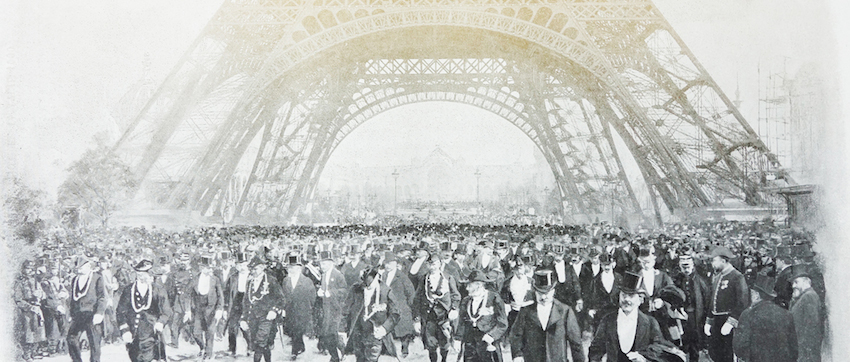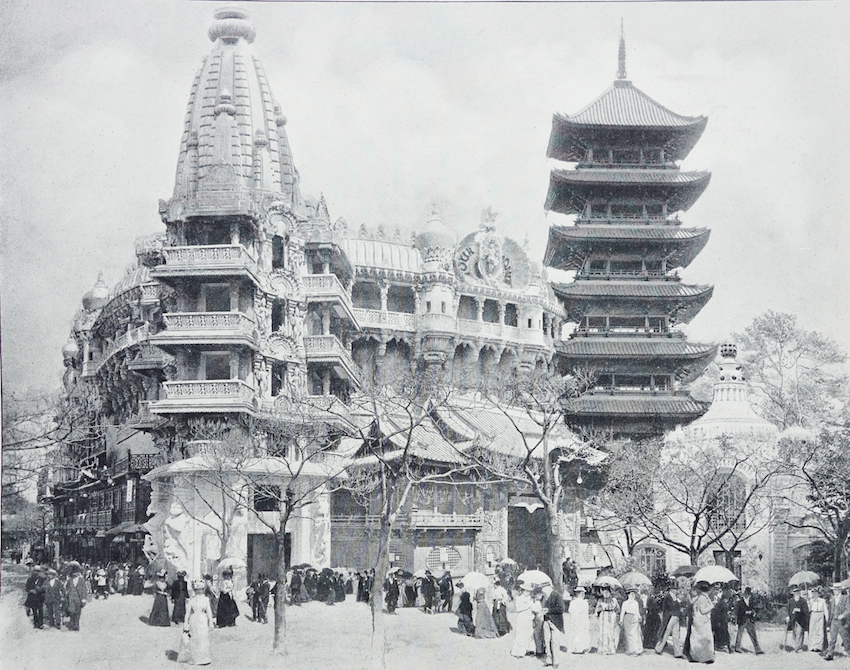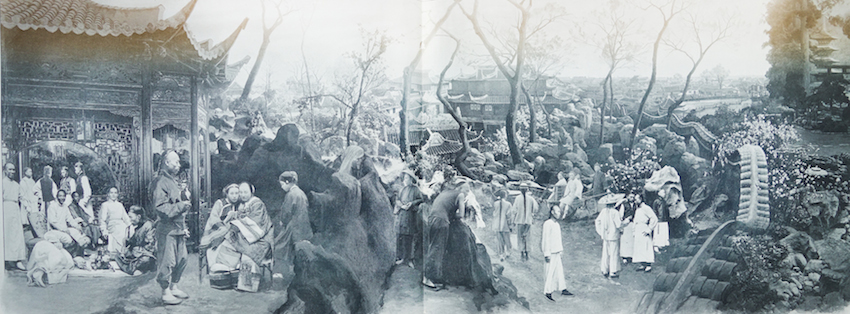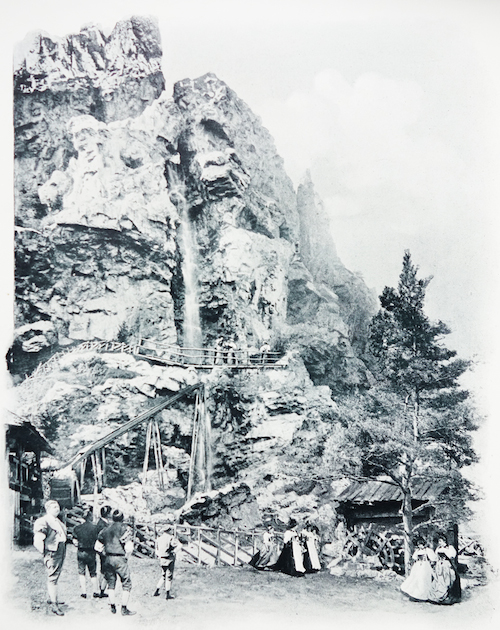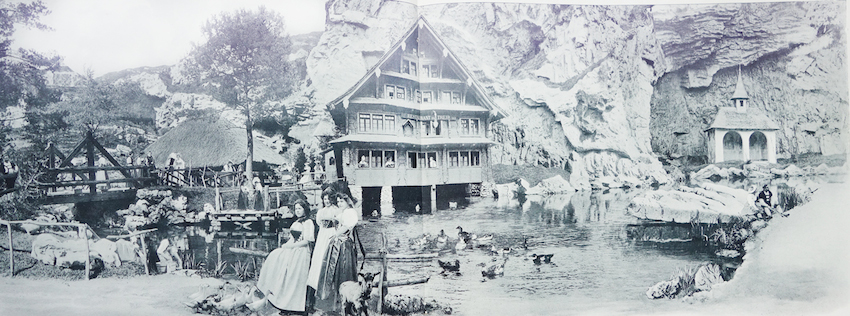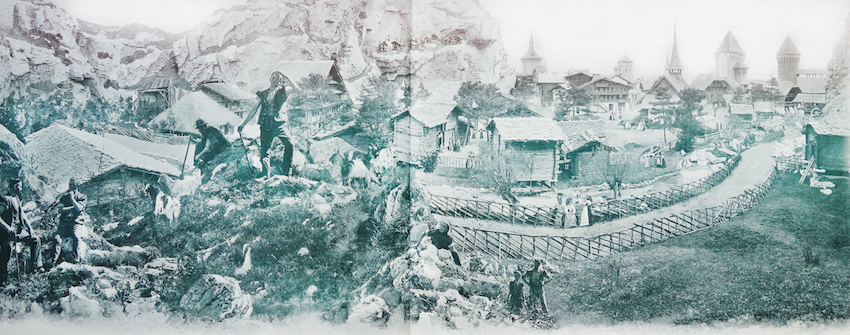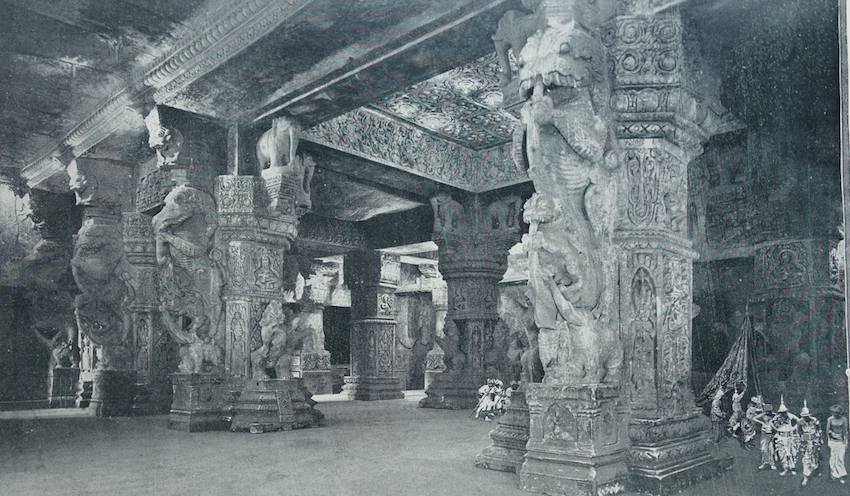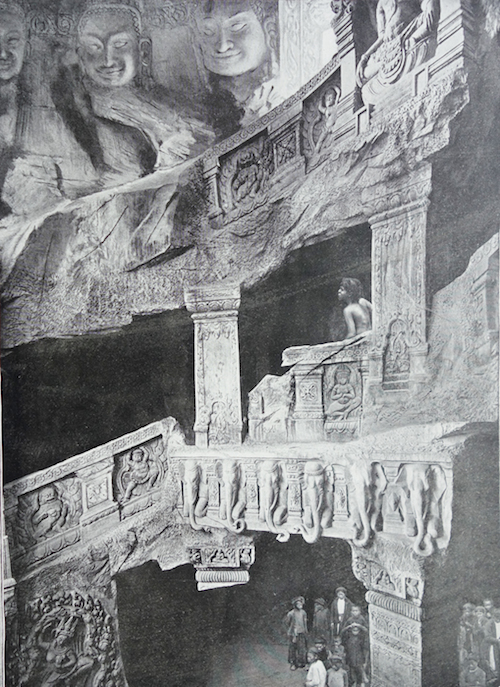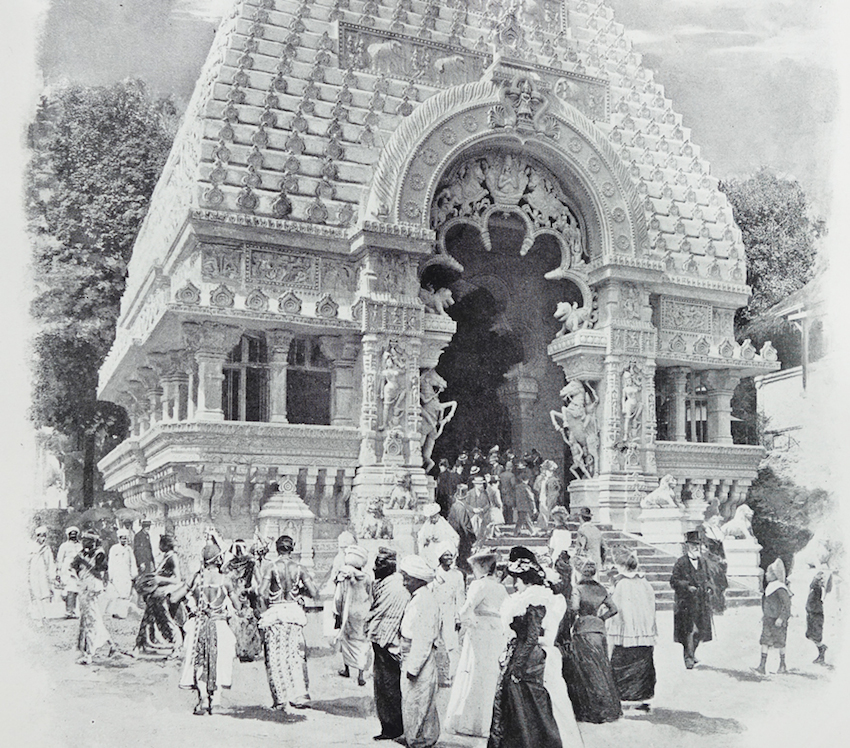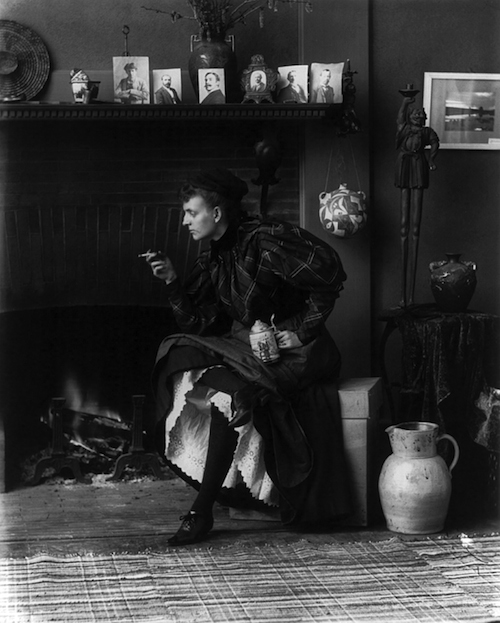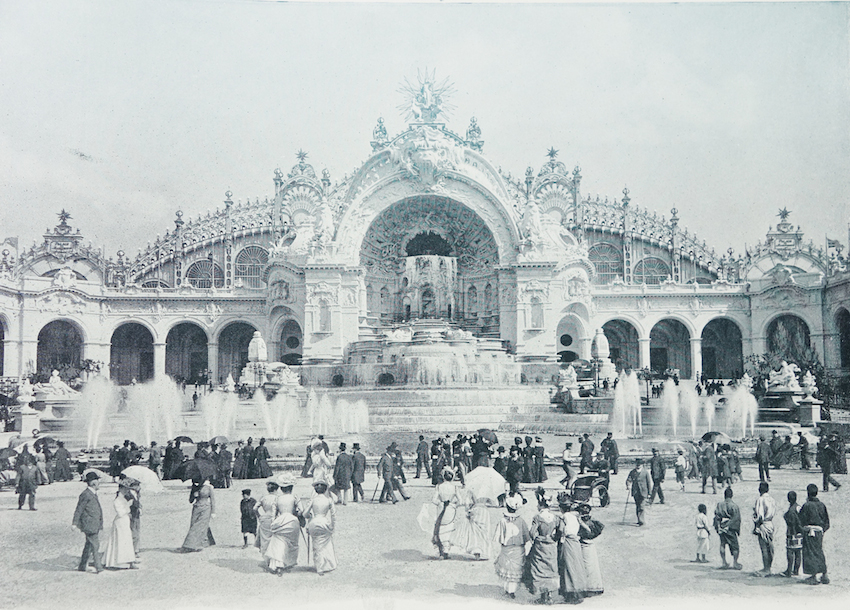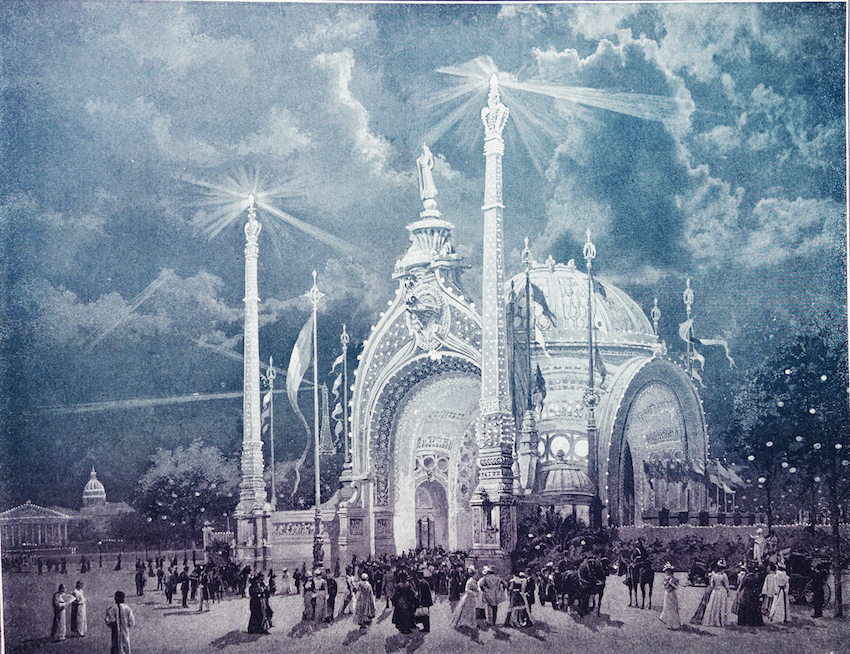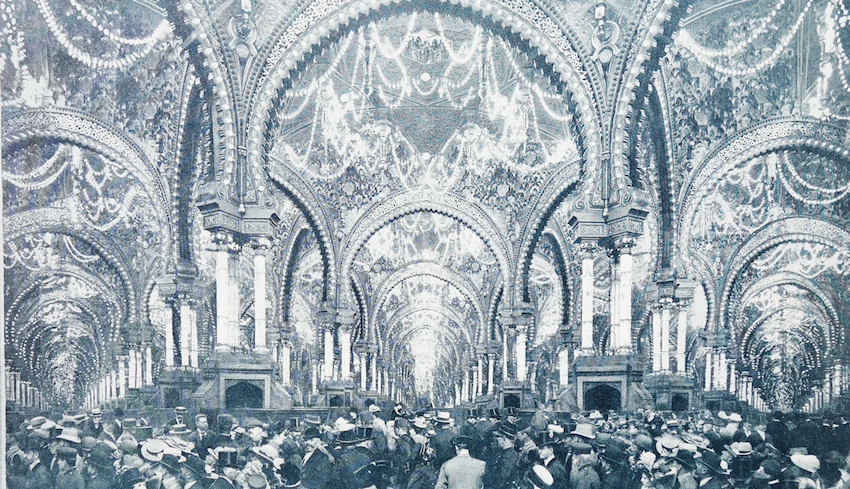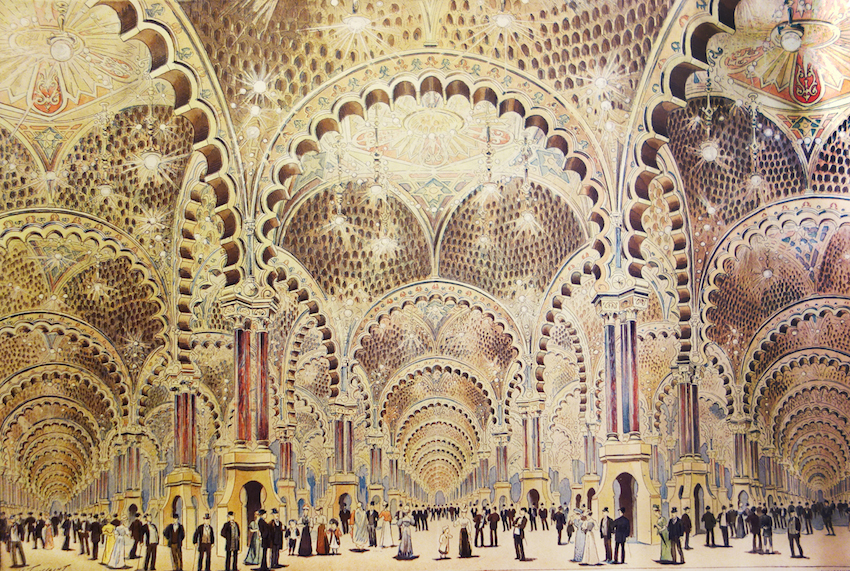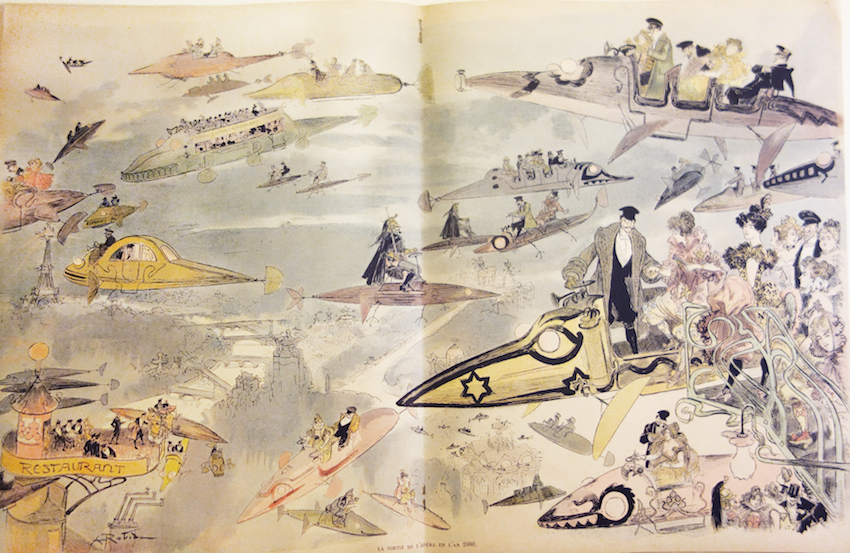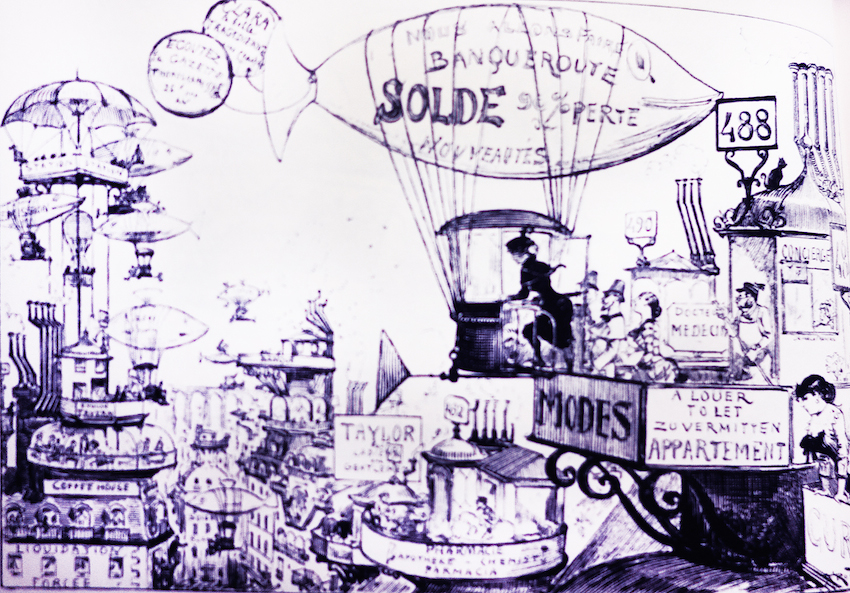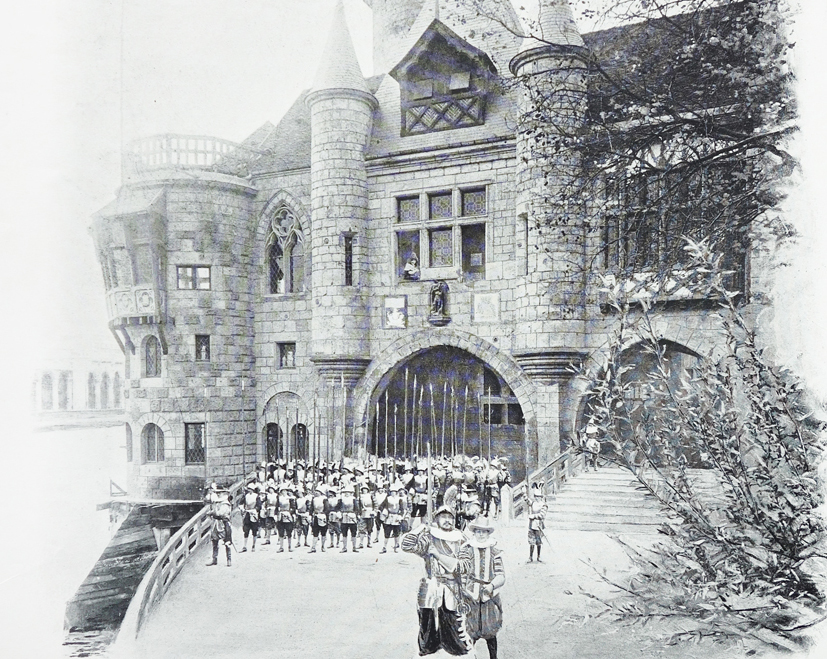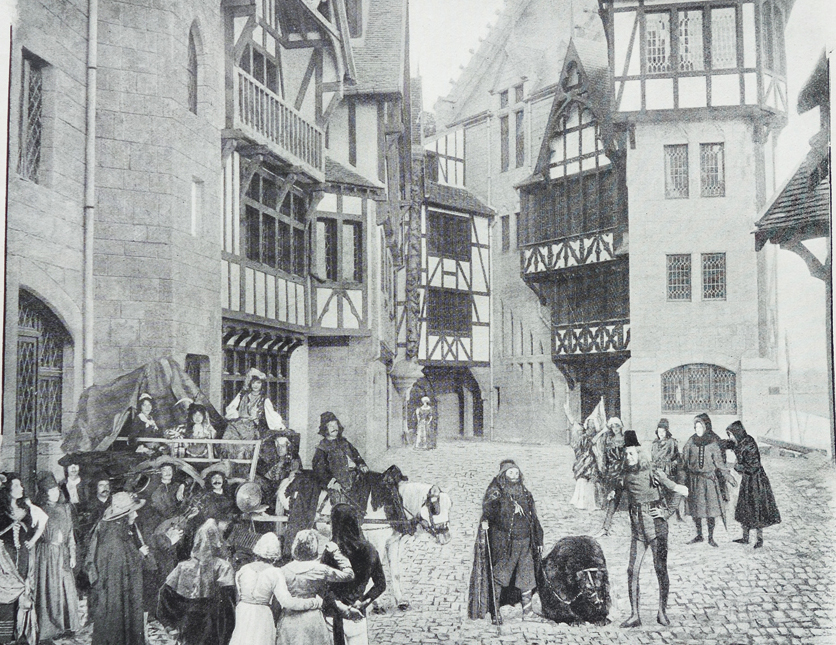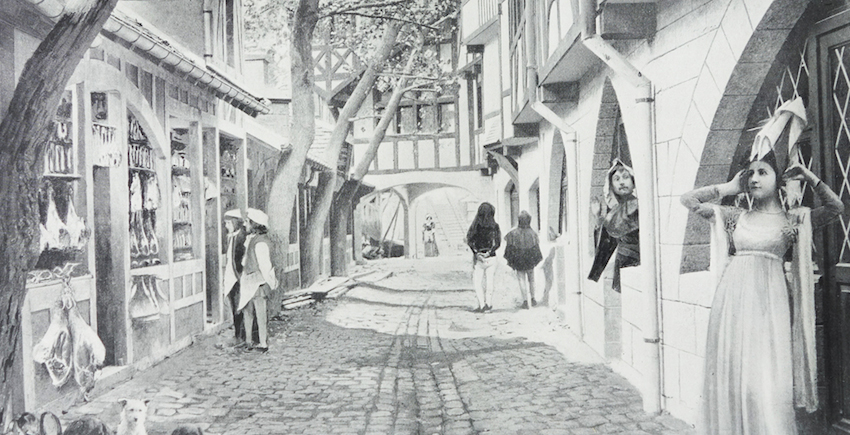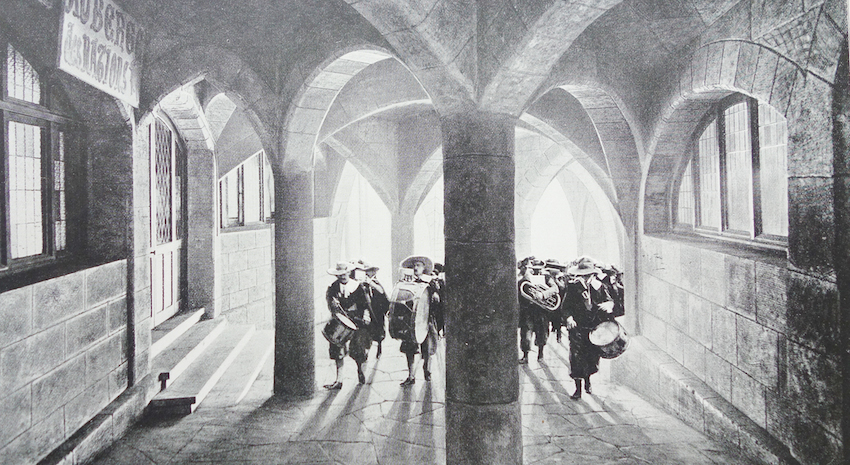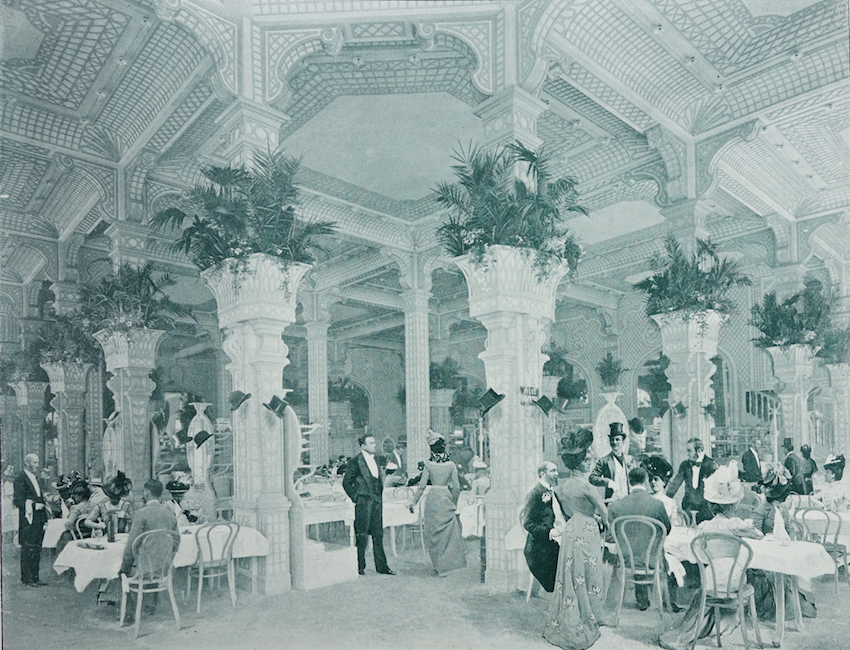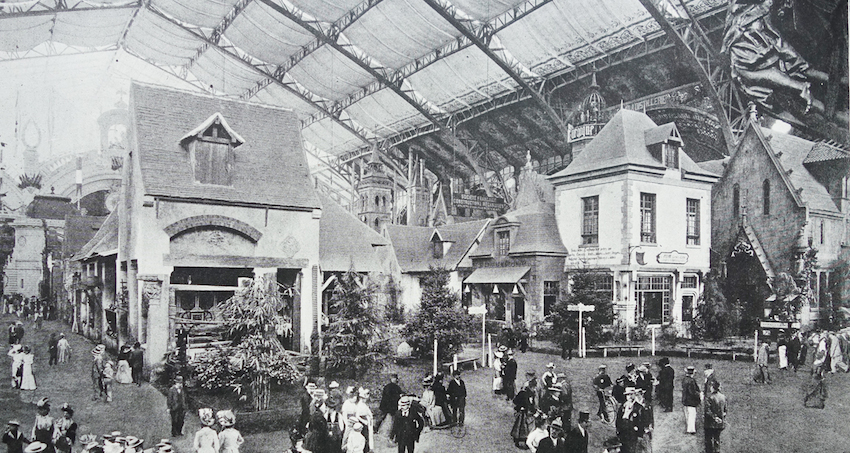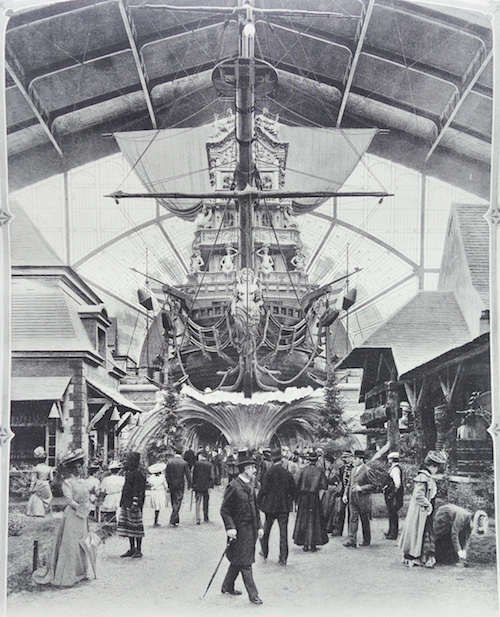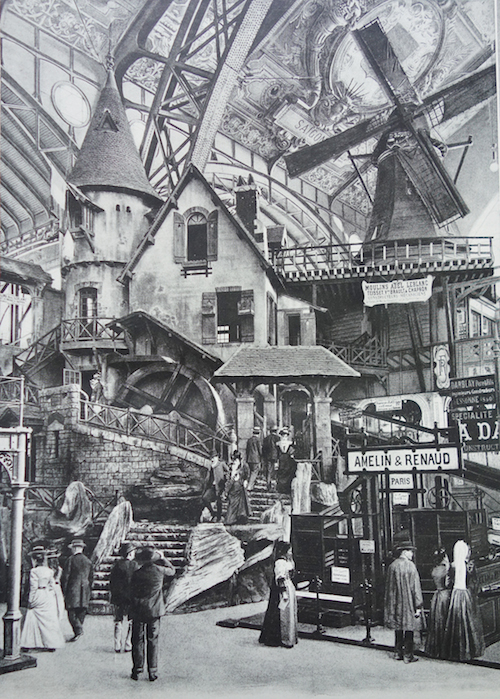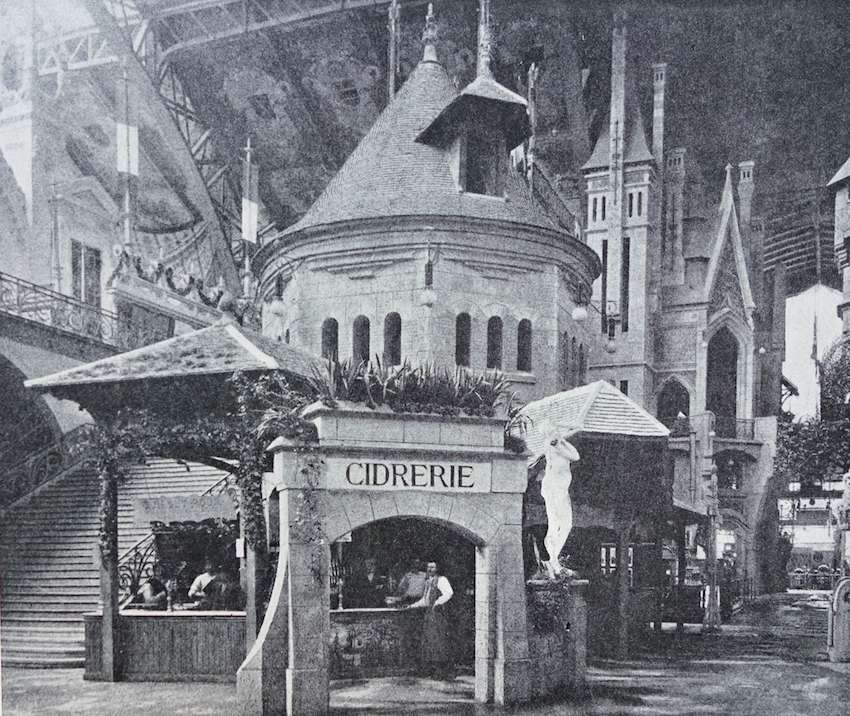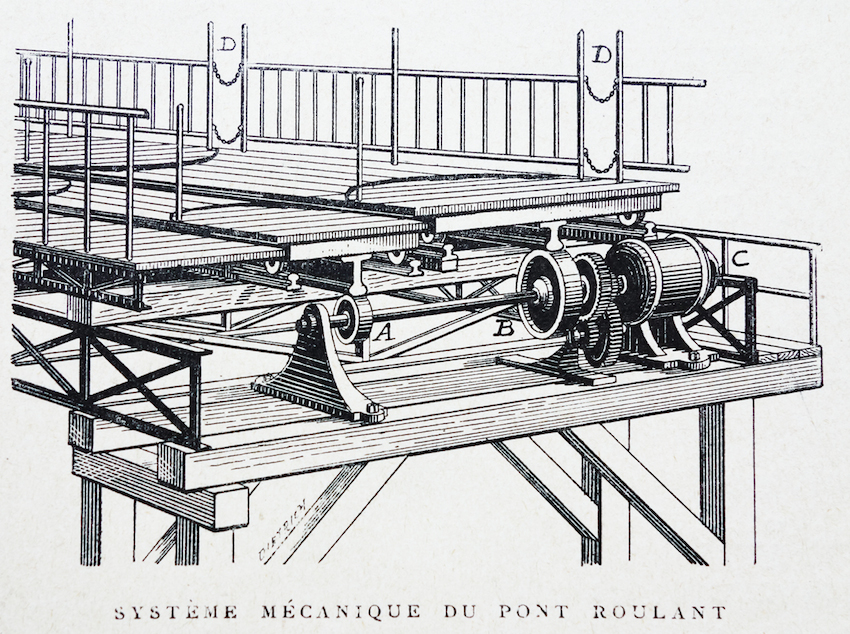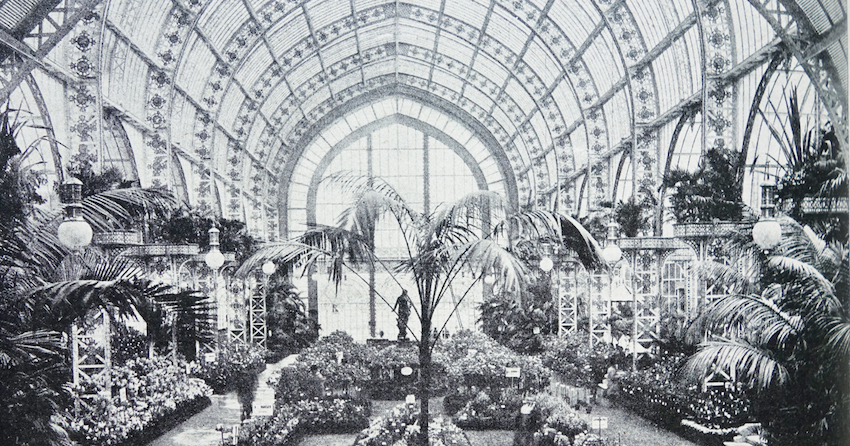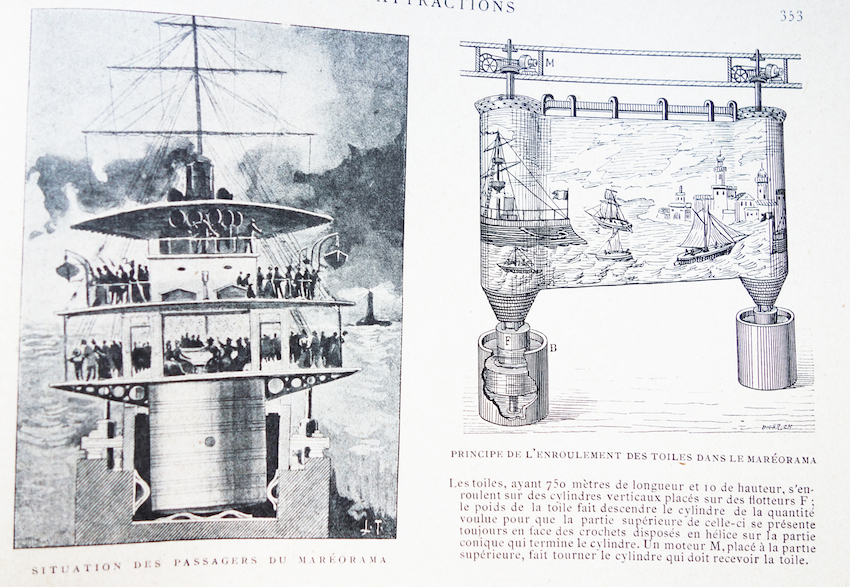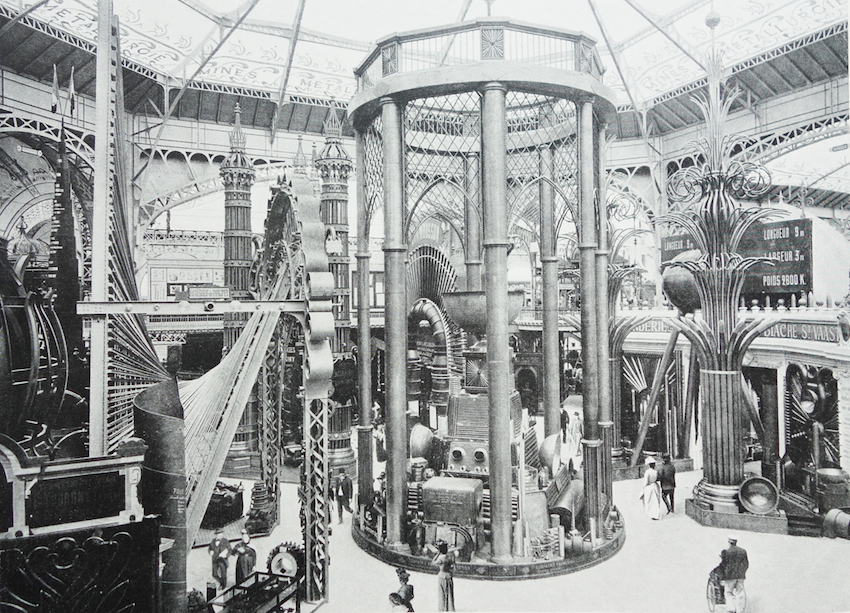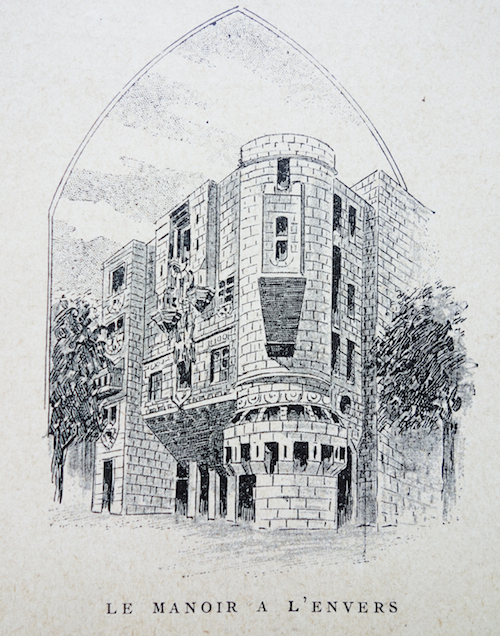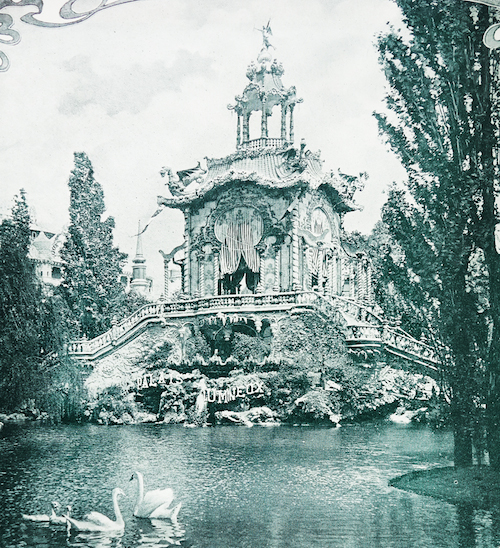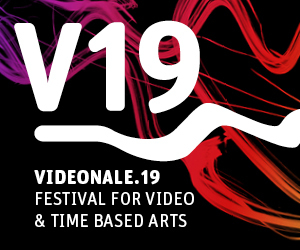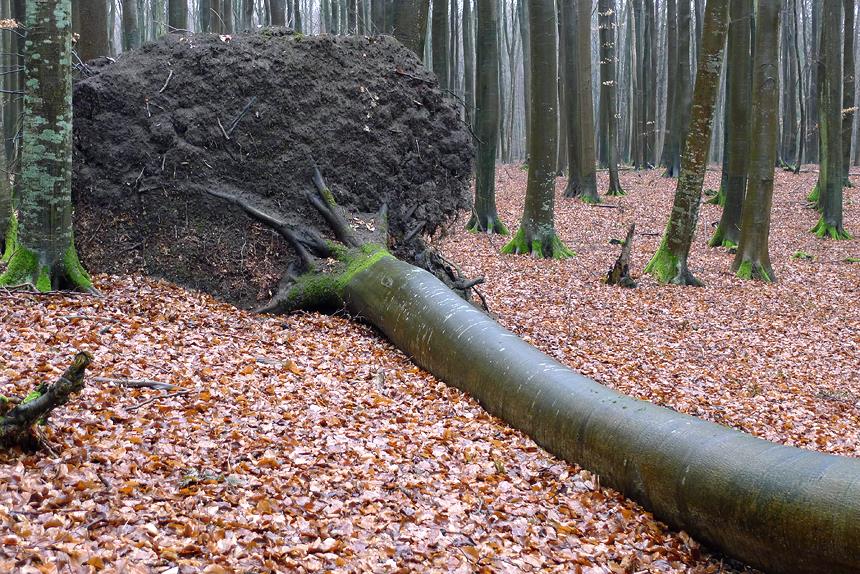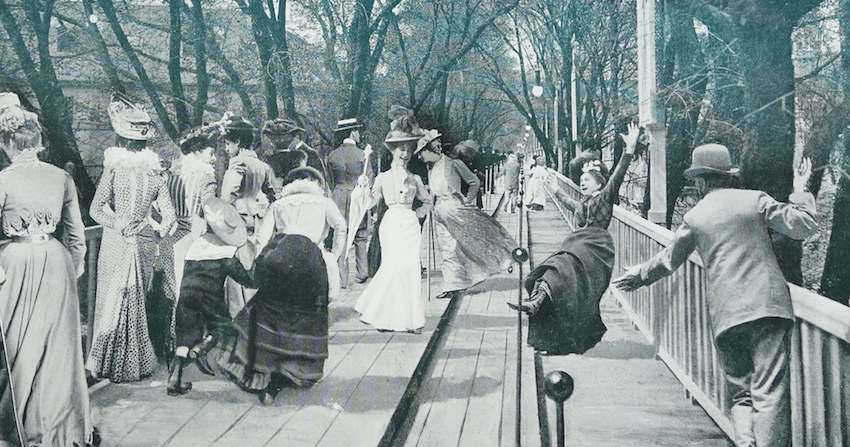
Come with me to Neverland
/ DE /
A walk across the Expo 1900, or rather a simulation using several illustrations from old books of the Richter Collection.
The Exposition Universelle in 1900 is a dream. It is really, and I’m not lying, it’s truly just pure circumstance that I am now writing for this forum and for kaput magazine about my two favorite expos, just as Expo 2015 is opening in Milan. I had suppressed this, because I hate modern Expos. They bore me to death. Why that is so will be shown using countless documents from days long past.
I thus turned to several books on the Expo 1900 published at the time, prints and accompanying material that made themselves at home in my expo-corner. Albert Robida will play a rather central role, and we can be pleased that I have admired and collected Robida for some time, because this allows me a brief excursion into the world of this almost forgotten artist.
The Exposition Universelle from 1900, like Expo 2000, was a turn of the century expo. Indeed, Expo 2000 was even a change of the millennium expo, but nothing in comparison to what was on offer in Paris in 1900.
Let’s see if I’m exaggerating. Off to the opening:
The Eiffel Tower, the ultimate expo building, was already standing when a world exhibition was held for the fifth time. So it was necessary to give one’s all to add something to the loveliest of all technophile buildings. And so, around the site and along the Seine, a genuine theme park of attractions was created, each one more spectacular than the next. Let us begin our tour with the “tour du monde,” a virtual exhibit of the world’s cultures, the building looked like this:
Inside and on the grounds outside, alongside, there was an elaborately designed terrain where the European, still not a regular traveler, could marvel at foreign countries and practices. Today, this practice has justly come under heavy criticism, there are dissertations about the exoticism of the early twentieth century, and at many expos Africans, for example, were displayed like zoo animals.
And yet, the attempt to bring the world together in one place was also the beginning of our understanding of other cultures. Think of the immense influence that Japanese art shown at early expos had on the development of European art or how African art thrilled the Dadaists and expressionists. Here a view of the Asian world at “Tour du Monde”:
At the time, a great deal was exotic, and exotic was popular. The world was exciting and new and an idyllic Swiss mountain village could become an attraction. In a kind of pre-Disneyland-scenery, a village was created as an accessible, enacted stage-set world in Paris, including a waterfall, mountains, and a lake.
The panorama clearly shows the constructedness of the ensemble, and it is precisely this theatricality of the architecture that charms me:
A wider view shows how large the site alone was:
I would like to know whether there were also artificial caves in the artificial mountains, or whether the staff would have small resting areas where they could picnic the sandwiches they brought with them. Ever since I found out that Disneyland’s artificial Matterhorn contains a secret basketball court in the upper area, I have been obsessed with secret rooms in stage-set constructions.
Let us move on in the world, it is, after all, a world exhibition.
French colonialism led to a presentation of Cambodia, in 1900 a reconstruction of underground temples was on view. A construction that I still find impressive today, way down there, the little dwarfs, they are people!
I find that a rather impressive set. How was something like that built? Impressive enough for another detail photograph:
The “pagoda of Vichnou” is also impressive:
Although all these colonially appropriated culture were not equally presented as “art” but rather as exotic attractions, the artists like Rodin and Eric Satie were so lastingly impressed that they deepened their research on the foreign cultures, praising their beauty, and appropriating parts of the foreign world, including them in their own works. Cultural globalization, that’s where it started.
To save the reputation of Expo 1900, we should mention that in a time when people of non-European cultures were often presented like zoo animals, at Expo 1900 Frances Benjamin Johnston showed her marvelous photographs of African-American students, taken at Booker Washington’s Hampton Institute, an act of great emancipatory strength in the culture that was so thoroughly racist at the time.
Booker Washington was amazingly cool, as was Frances Benjamin Johnston too: her self-portrait from 1896 with beer and cigarettes speaks volumes for those who can read the signs:
Not only was the exotic charm of foreign lands relatively new for the European population, electricity was also something worthy of presentation. In the “Palais de l’electricité,” photographed here together with the “Chateau d’eau.” I mean: “Chateau d’eau,” that already sounds wonderful!
At night, these buildings were illuminated by countless electric light bulbs, an effect that was already used in early amusement parks like Luna Park on Coney Island. These nocturnal worlds must have been of such great beauty that for example Windsor McCay based several of his amazing drawings for Little Nemo on this architecture of light. For an impression of the Paris scene, see below:
One of the artistic works of art, the Porte Monumentale by architect René Binet, glowed at night like a mysterious crystal. The Parisians themselves hated the building, they found it too kitschy and exaggerated even back then. The ticket counters for the expo were located in the corridors, and every conceivable spot was filled with decorations and images of natural structures, like beehives, dinosaur bones, and flower petals. At the time, the style was called “Salammbô Style,” borrowing from Gustave Flaubert’s marvelous, feverish and ornamental book Salammbô, today I find both the book and the gate wonderful:
The visitor could truly sink into a world of light and magic at the Palais des Illusions, a hall of columns that is seemingly endless through the use of mirrors and lights, where various moods were evoked using colored electric light, music, and mechanically moving columns:
I have a contemporary print that shows how impressive the illusion was:
Was? Is!
Palais des Mirages was one of the few attractions to be saved, and is located today at Paris’ Musée Grevin, I am not really sure whether it is really the Palais des Illusions (called in all the documents) and is now just called “mirages” instead of “illusion,” or whether there was also a Palais des Mirages, in any case, it is a truly beautiful piece of culture, comes from Expo 1900 and can be recommended to any visitor to Paris. I have already been three times.
This is what it looks like:
Unfortunately, the masterpiece of theme architecture “Le Vieux Paris” is no longer extant—an old hobbyhorse ever since I heard of it years ago. There is so much behind this inventor of a pre-theme park world that several entries are necessary to do justice to him. Albert Robida.
In his time, Robida was a famous writer and drawer, he published countless illustrated books on the slowly disappearing historical architecture of France, while at the same time he was a wonderful visionary of the future, and created a work still today available in a later edition, Le vingtième siècle from 1883, one of his many unfathomable science fiction stories full of emancipated women, pollution, mass tourism, flat screens, television transmissions, flying devices and many other quite precise visions of the future. Of course, all illustrated masterfully by the master himself. Like every good artist, Robida stood with one leg deep in the past and with the other far in the future. A balancing act that is often quite productive. As said, Robida will become a subject of his own, but here a few of his futuristic illustrations:
For Expo 1900, Robida designed an entire city, a collection of historical buildings from the various ages of architecture in France. After walking through the powerful entrance gate, we found ourselves in an immense stage-set world, compiled of historical models and populated by actors dressed in historical costumes:
There were theaters, bars, and stores, all played and lived, one could spend a whole day in this city in the city, go to the theater and then stop for a drink later. Here an overview of the gigantic site:
Through the streets and alleys, actors strolled about to generate the impression of a piece of historical reality:
Shopping also took place here:
Musicians wandered around the halls and streets of papier-mâché, plaster and wood, and I think Le Vieux Paris anticipated in a grand way the worlds of the Disney theme park:
In Vieux Paris, there was even a newspaper, also designed by Robida. A few years ago, I was able to purchase a portfolio with several sketches that were then available as a souvenir. Here it is clear how Robida, on the one hand eclectic and on the other hand interested in historical precision, places building next to building, creating alleys and squares, designing the smallest detail in a minute way.
I’m exhausted. Let’s have a coffee at Restaurant Champeaux, which was also built especially for Expo 1900:
And now we move on. What are we looking at now? Agriculture! Agricultural products! Nothing could be more exciting, especially when it takes place in a stage-set city in an unused machine hall from the previous expo. A stage-set city! I love that!
So welcome to the world of food. Is the subject of Expo 2015 not food, after all?
In 1900, it looked like this:
When I saw these illustrations for the first time a few years ago, I was entirely charmed and it took a great deal of research to find out that this was really part of the expo, representing a kind of agricultural exhibition.
At the top is Le Triomphant, a ship that brought the first load of cacao under Louis IV from the Antilles to France. Le Triomphant was also the fair stand of the French chocolate maker Menier, inside of which one could inform oneself about the history of the company and probably enjoy some chocolate. The ship was entered through the rising waves at the bow.
The historical press release says, that one was trying to tried to present the various French food and drink in accordingly NACH buildings, slightly miniaturized, and that the overall image was to approximate a Nuremberg toy town. On the first floor of the hall, there is a VIP lounge, from which the whole arrangement could be overseen. (It is now perhaps unnecessary to mention that I go mad at the idea, of once being able to stand there, sent there by the not yet invented time machine.)
There were mills too:
Since just for this article I purchased a really expensive 115 year old book , I cannot refrain from presenting the overall view of the hall taken from this work:
And so every cent was worth it: here the other side of the hall:
So, let’s take a tiny refreshment, then go on.
Let’s take the moving sidewalk, but careful, hold on tight!
This mechanical pavement ran three kilometers across the expo grounds and had 10 stations where one could enter and exist. There had been a plan to outfit the whole city of Paris with the moving sidewalks, but, as so often, this vision failed.
Thomas Edison personally did us the favor of capturing the moving pavement (known today from the world’s airports) on film:
Moving Sidewalk at the 1900 World’s Fair in Paris from Gizmodo on Vimeo.
I found a construction sketch in one of my books, so if anyone wants to build one:
There’s so much to see, we won’t get to it all, time is too short.
Perhaps let us look briefly at the huge telescope in Palais de l’optique, that casts an image of the moon in unlikely focus and detail onto a small screen!
Or take a rest in one of the countless greenhouses of the plant exhibition.
Perhaps to the Maeorama, where a boat trip is simulated in such a genuine way that one can almost get seasick:
Or observe the progress of metalwork?
Or perhaps rather to “Manoir a l’envers,” the upside-down castle?
One can see that the Exposition Universelle 1900 would be the ideal place for somebody who loves stage sets and fantastic ideas, for example, for me.
Modern expositions cannot hold up to that, the tastes of the time has changed, and our view of the world as well. Sustainability and recycling are today the issues, population growth and globalization have shifted the spectrum of the expos towards a rather pedagogical and reduced approach to spectacle—and it is probably better that way. But perhaps it would be possible to let a bit of megalomania in, a bit of madness, a bit of craziness. And with this I don’t mean the wasted funds against which demonstrations are taking place on the streets of Milan, I mean a few buildings out of papier-mâché in an old hall or a magical forest with speaking animals or a land of nonsense.
But nobody listens to me, so I’ll go have some tea at Palais Lumineux and wait until it gets dark, so that my hot air balloon, outfitted with 4000 lights, looks at its best, and with which I can float on over to my other column in kaput magazine on the last great expo, Expo 70 in Osaka.
For those who want to come along:
And those who are now, like me, fans of expo 1900, should enjoy this wonderful site:
http://exposition-universelle-paris-1900.com/
Claus Richter is an artist living in Cologne.

